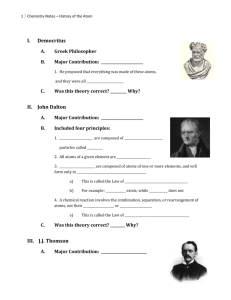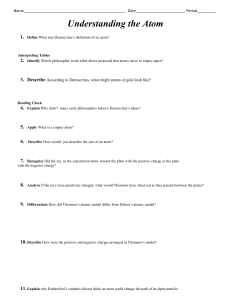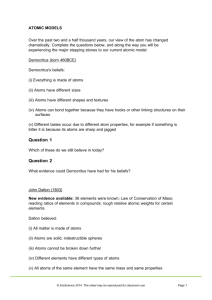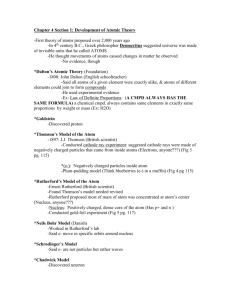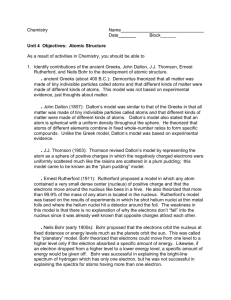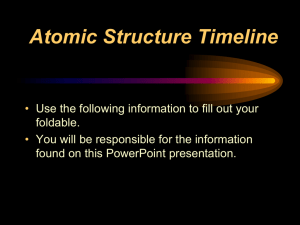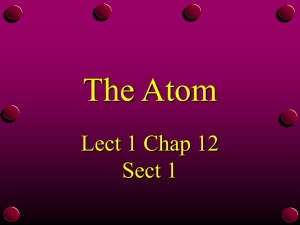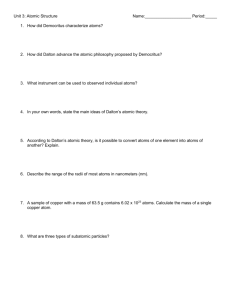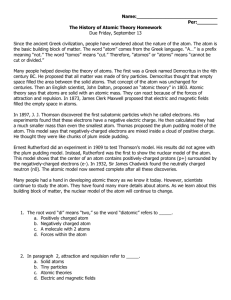history_of_the_atom_
advertisement
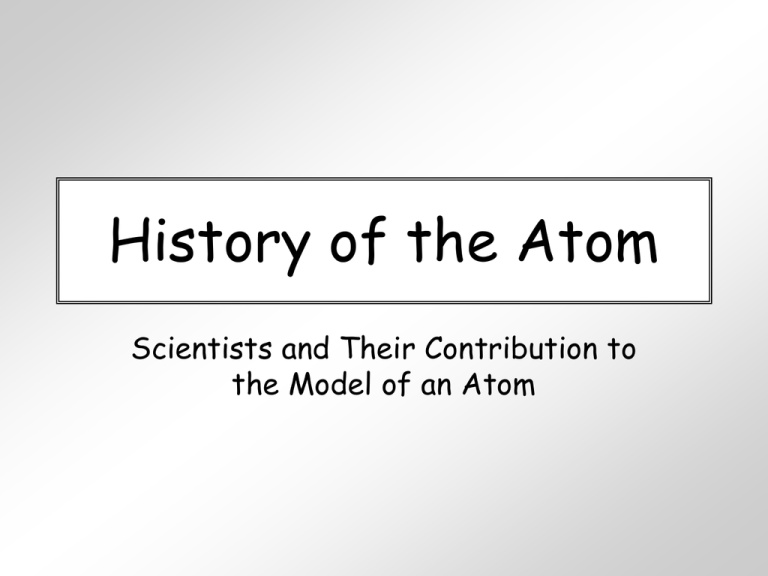
History of the Atom Scientists and Their Contribution to the Model of an Atom Democritus (460 BC – 370 BC) • Proposed that all atoms are small, hard, indivisible and indestructible particles made of a single material formed into different shapes and sizes. • Aristotle did not support his atomic theory Image taken from: https://reichchemistry.wikispaces.com/T.+Glenn+ Time+Line+Project Aristotle (350 B.C.) • modified an earlier theory that matter was made of four “elements”: earth, fire, water, air. • Aristotle was wrong. However, his theory persisted for 2000 years! John Dalton (1766 – 1844) In 1803, proposed an Atomic Theory which states: o All matter is made of atoms. o Atoms are indestructible – can’t be divided. o All atoms of one element are exactly alike. o Atoms join with other atoms to make new substances. Calculated the atomic weights of many various elements Image taken from: chemistry.about.com/.../JohnDalton.htm J.J. Thomson (1856 – 1940) Image taken from: www.wired.com/.../news/2008/04/d ayintech_0430 Proved that an atom can be divided into smaller parts While experimenting with cathode-ray tubes, discovered electrons Stated that the atom is neutral In 1897, proposed the Plum Pudding Model which states that atoms mostly consist of positively charged material with negatively charged particles (electrons) located throughout the positive material Won a Nobel Prize Chocolate chip cookie dough model Ernest Rutherford (1871 – 1937) In 1909, performed the Gold Foil Experiment and suggested the following characteristics of the atom: o The protons are surrounded by negatively charged electrons, but most of the atom is actually empty space o It consists of a nucleus, that contains most of the mass of the atom o This nucleus is made up of particles called protons, which have a positive charge Did extensive work on radioactivity (alpha & beta particles, gamma rays/waves) and was referred to as the “Father of Nuclear Physics” Was a student of J.J. Thomson Image taken from: http://www.scientificweb.com/en/Physics/Biographies/Er nestRutherford.html Niels Bohr (1885 – 1962) Image taken from: commons.wikimedia.org/wiki/File:Ni els_Bohr.jpg In 1913, proposed Bohr Modelsuggests electrons travel around the nucleus of an atom in orbits or definite paths. Additionally, electrons can jump from a path in one level to a path in another level (depending on their energy) Won a Nobel Prize Worked with Ernest Rutherford History of the Atom - Timeline 1766 – 1844 Antoine Lavoisier Thomson makesJ.J. a substantial the number discovers of contributions electron and to the field of proposes the Chemistry Plum Pudding Model 1871 in 1897 – 1937 Niels Bohr proposes the Bohr Model in 1913 1887 – 1961 James Chadwick discovered the neutron in in 1932 1700s 1800s 1900s 460 – 370 BC 0 Democritus proposes the 1st atomic theory 1743 – 1794 Erwin John Dalton Ernest Rutherford Schrodinger proposes performs his the Gold Foil describes 1891 – 1974 atomic theory Experiment in in 1909 the electron 1803 cloud in 1926 1885 – 1962 Click on picture for more information 1856 – 1940 Progression of the Atomic Model - - - - --+- - + - - The structure of an atom, according to: Electron Cloud Democritus James Ernest Erwin Neils Schrodinger Chadwick Rutherford Bohr& J.J. Thomson John Dalton

